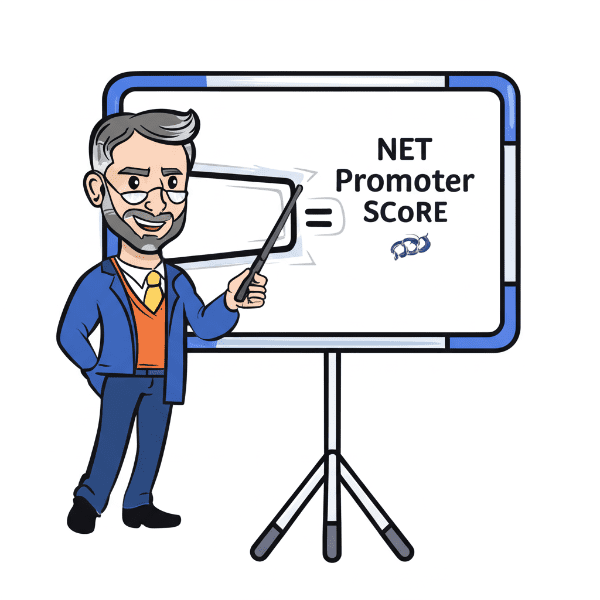Table of Contents
Introduction
As sales and marketing leaders, we’re constantly evaluating performance, and the Net Promoter Score (NPS) has become one of the most talked-about metrics for measuring customer loyalty. While we track conversion rates, customer acquisition costs, and pipeline velocity, NPS offers a direct lens into how customers perceive your brand and their likelihood to recommend it.
That single Net Promoter Score (NPS) figure you see reported—is it really a definitive measure of customer sentiment, or just one data point among many? Understanding the meaning behind NPS, how it’s calculated, and its strategic implications is essential for moving beyond vanity metrics toward actionable growth.

This article dives into the full meaning of NPS, how to calculate it, and how sales and marketing leaders can use it to drive outcomes.
What is Net Promoter Score (NPS)?
Net Promoter Score (NPS) is a customer loyalty metric developed in 2003 by Fred Reichheld of Bain & Company and Satmetrix. Its core function is to measure how likely your customers are to recommend your brand to others—an indicator of loyalty and future behavior.
Rather than focusing on satisfaction alone, NPS aims to assess the likelihood of advocacy. That makes it predictive of organic growth through referrals and long-term retention.
The Core NPS Question
“On a scale of 0–10, how likely are you to recommend [Company/Product/Service] to a friend or colleague?”
The simplicity of the question belies its depth. The willingness to recommend implies a level of trust, satisfaction, and emotional connection strong enough to stake one’s social capital.
NPS Score Segmentation: Promoters, Passives, Detractors
Customers who respond to the core question fall into one of three categories:
Promoters (Score 9–10)
- Extremely satisfied and loyal customers.
- Likely to make repeat purchases.
- Refer new customers through positive word-of-mouth.
- High Customer Lifetime Value (CLTV).
Passives (Score 7–8)
- Moderately satisfied but unenthusiastic.
- Vulnerable to competitors’ offerings.
- May churn without warning.
- Typically do not promote your brand.
Detractors (Score 0–6)
- Unhappy and dissatisfied.
- At high risk of churn.
- Potential source of negative word-of-mouth.
- Can damage brand reputation.
Understanding the behavior of each group is critical for interpreting your score and taking strategic action.
How to Calculate Net Promoter Score
The NPS formula is simple:
NPS = % of Promoters – % of Detractors
Passives are counted in your total survey sample but do not factor directly into the formula.
Step-by-Step Example:
Out of 100 survey respondents:
- 40 are Promoters (score 9–10)
- 40 are Passives (score 7–8)
- 20 are Detractors (score 0–6)
NPS = 40% – 20% = 20
Scores range from -100 (all Detractors) to +100 (all Promoters).
Types of NPS Surveys
Relational NPS
- Measures overall brand sentiment and customer loyalty.
- Sent periodically (e.g., quarterly or annually).
- Useful for benchmarking long-term brand perception.
Transactional NPS
- Sent after specific interactions (e.g., purchase, support call).
- Measures satisfaction with a specific moment or touchpoint.
- Helps pinpoint CX issues or process gaps.
Use both types in tandem to get a complete picture.
Key Considerations for Accurate NPS
- Sample Size: Larger and more diverse samples lead to statistically valid insights.
- Data Hygiene: Exclude incomplete or invalid surveys.
- Survey Timing: Choose key moments in the customer journey for optimal feedback.
- Cultural Factors: Consider regional scoring tendencies when analyzing global responses.

Interpreting Your NPS Score: Beyond the Number
What is a “Good” NPS?
- Above 0 = more Promoters than Detractors (positive sentiment).
- 30–50 = strong and competitive in many industries.
- 70+ = exceptional and rare, typically seen in beloved brands.
But context is crucial—what’s considered strong in tech may be average in telecom.
Don’t Ignore the Distribution
Two companies could have the same NPS score with vastly different customer profiles.
- Company A: 50% Promoters, 0% Passives, 50% Detractors → NPS = 0
- Company B: 20% Promoters, 60% Passives, 20% Detractors → NPS = 0
Different score, different strategy. Company A has polarization, while Company B has apathy. Each requires tailored follow-up.
The Strategic Power of Qualitative Feedback
Always include a follow-up question such as:
“What’s the primary reason for your score?”
This open-ended feedback is the why behind the score and reveals recurring issues, praises, or gaps in the customer journey.
Analyze themes using sentiment analysis or manual categorization across:
- Product features
- Onboarding experience
- Customer support
- Pricing
- Delivery logistics
This allows teams to prioritize improvements that matter most.
Segmenting NPS for Deeper Insights
Slice your NPS results by:
- Customer type (new vs. returning)
- Product/service line
- Region or language
- Customer lifecycle stage
- Support team or sales rep
This enables targeted intervention, proactive support, and stronger messaging.
NPS and Business Outcomes
Retention and Churn Reduction
Detractors are more likely to churn. Proactively engaging them through follow-ups, service recovery, or account reviews improves retention.
Word-of-Mouth and Referrals
Promoters are natural brand advocates. Leverage their enthusiasm by:
- Asking for testimonials
- Launching referral programs
- Creating case studies
Revenue Growth
Promoters drive higher LTV, are less price-sensitive, and lower acquisition costs through referrals. Increasing your NPS often correlates directly with revenue growth.
Putting NPS to Work: Operationalizing the Data
For Promoters:
- Invite to loyalty programs
- Ask for social proof and reviews
- Reward advocacy with recognition or incentives
For Passives:
- Personalize follow-ups
- Highlight underused features
- Offer limited-time upgrades or content
For Detractors:
- Apologize sincerely
- Offer recovery or solutions
- Escalate to customer success teams
Limitations of NPS
Despite its utility, NPS has limitations:
- One-question oversimplification: Doesn’t capture complex relationships.
- Cultural bias: Some cultures tend to avoid extreme scores.
- Gaming risk: Employees might pressure customers to rate higher.
- Lack of context without follow-up: Quantitative scores are meaningless without qualitative insight.
Complementary Metrics to NPS
Use NPS in concert with:
- Customer Satisfaction (CSAT): Short-term feedback on specific interactions.
- Customer Effort Score (CES): Measures how easy it was to interact.
- Churn Rate: The hard outcome that NPS can predict.
- CLTV: Financial metric impacted by loyalty and advocacy.
Together, these provide a holistic CX performance framework.
Industry Benchmarks and Applications
Technology/SaaS
- Frequent use of transactional and relational NPS
- Links scores to usage and onboarding
- NPS often tied to product roadmap
Retail/E-commerce
- Post-purchase and return experience
- Delivery, packaging, and refund process insights
Financial Services
- Trust and clarity in account handling
- Security concerns and process transparency
Healthcare
- Patient experience
- Communication, wait times, clarity of treatment
Hospitality and Travel
- Reservation and booking ease
- On-site experience and staff interactions
B2B vs. B2C
- B2B: Requires surveying multiple stakeholders in long-term relationships
- B2C: Faster feedback loops, more transactional sentiment
Best Practices for Implementing NPS Programs
- Educate internal teams on NPS value
- Share NPS data across departments
- Close the loop with survey respondents
- Track trends over time, not just one-off scores
- Tie NPS initiatives to customer journey maps
Real-World Examples
- Apple: Consistently high NPS due to seamless product experience and emotional brand loyalty.
- Amazon: High convenience and low effort drive frequent promoter behavior.
- B2B SaaS firms: Use NPS to refine onboarding, inform support training, and reduce churn.
Final Thoughts
Net Promoter Score is far more than a number. For sales and marketing leaders, it’s a strategic lens into customer loyalty, advocacy, and brand perception. When used correctly—and with context—it becomes a catalyst for action, not just reporting.
The power of NPS lies in the insights behind the score. Collect qualitative feedback, segment your data, take decisive action, and build a culture around customer voice.
Want to go deeper?
Explore how NPS integrates with other performance metrics to build a customer-centric strategy that boosts retention, advocacy, and long-term revenue.
Useful Blogs from Sales Funnel Professor
- Growth Consulting Guide for Sales & Marketing Leaders
A deep dive into how growth consulting helps leaders accelerate revenue, overcome obstacles, and implement expert strategies to drive measurable performance - “Your Shortcut to High Velocity Funnels: Master Brand Positioning Strategy”
Explores how positioning clarity accelerates funnel velocity, improves conversions, and enhances messaging—crucial for building trust and advocacy in your customer base - Scalable Local Marketing Frameworks
Offers strategic guidance for multi-location brands to balance centralized brand consistency with localized engagement—ideal for increasing NPS across diverse geographies - Inside Sales vs. Outside Sales: Choosing the Right Sales Model
Helps leaders understand which sales model suits their needs, improve alignment, and ultimately influence customer experience and loyalty - Done For You Sales Funnel: Outsource for Faster Growth
Examines the strategic decision to outsource funnel creation for speed and efficiency—ideal for leaders optimizing customer touchpoints and collecting quality feedback - Pushing the Envelope in Business: Innovate to Grow
Sticking to old methods can hold you back. This guide helps sales and marketing leaders drive innovation and performance while staying grounded. - Sales Funnel vs Pipeline: What’s the Real Difference?
Sales funnel vs sales pipeline—what’s the difference? Learn how they work, where they overlap, and why the distinction drives better strategy.


